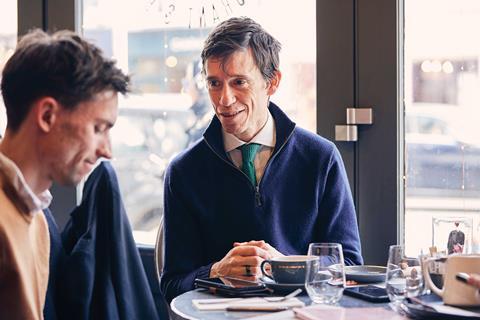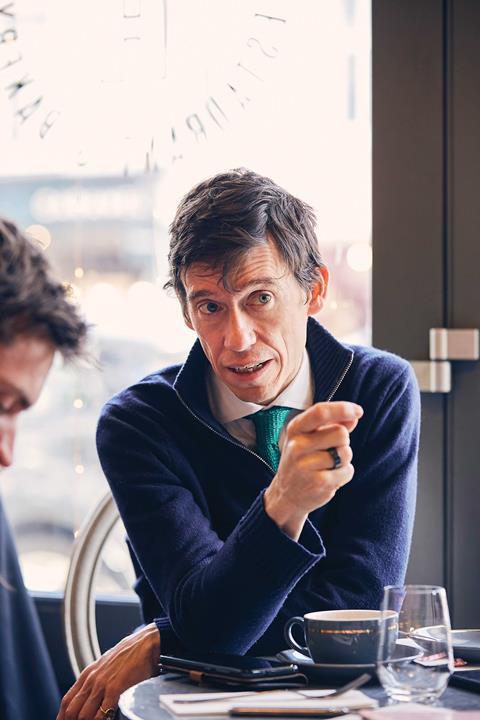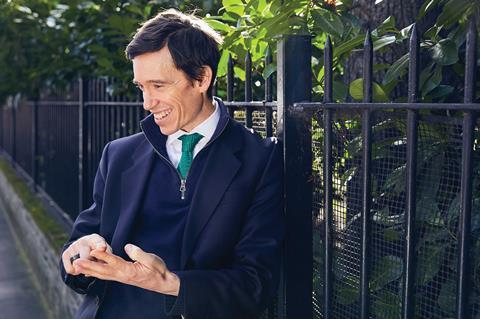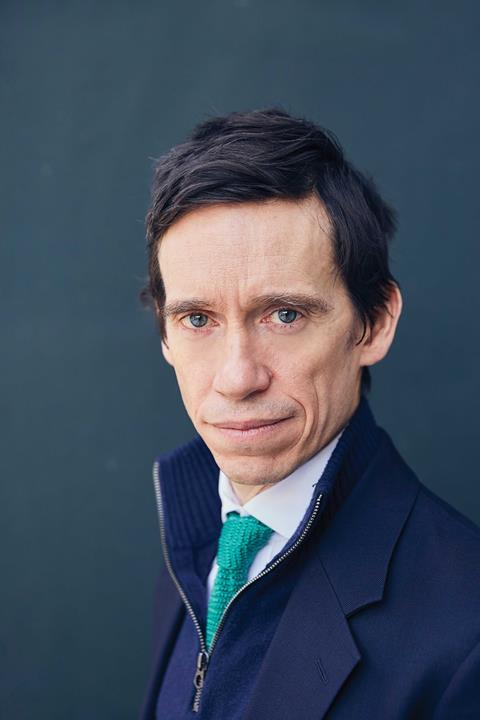Rory Stewart wants to be mayor of London and in an eye-catching series of announcements has set out his plans for the built environment. He faces an uphill battle to win the election – but it is a challenge he is clearly relishing, Tom Lowe reports. Photography by Tom Campbell

Thirty minutes after launching a startlingly ambitious housing policy for London, Rory Stewart is talking in a sunlit French restaurant just around the corner from his South Kensington home. On the menu is lemon sole for £22 or lobster spaghetti for £28. But he is only drinking a flat white, a faux pas made worse by the flapping of a giant reflective disc being held aloft by Building’s photographer.
“Scott,” Stewart says, leaning over to an aide, “could you please order yourself some food, because I’m feeling guilty towards the restaurant. And apologise,” he adds, flashing a smile at a passing waiter.
Unfailingly polite, Stewart seems an unlikely candidate to take a hacksaw to the capital’s planning policy. On this bright winter afternoon, a key media day for his London mayoral campaign, he seems almost as concerned with not distracting his fellow diners from their Chablis as he does setting out how he plans to fix London’s chronic housing shortage.
It is clear that he very much intends to screw up the re-election bid of his chief rival, the current mayor Sadiq Khan
When a bag at a neighbouring table falls off a chair onto the floor, he gently picks it up and puts it back. “I’m afraid we’re screwing up the whole restaurant,” he says. Yet with his targeted announcement, trending throughout the day on political twitter, that he wants to build 250,000 houses during his four-year term if he wins this year’s mayoral race, it is clear that he very much intends to screw up the re-election bid of his chief rival, the current mayor Sadiq Khan.
The Eton and Oxford-educated former MP has hired a crack team to run his campaign, Rory For London, who have already caught the media’s attention with “Come Kip With Me,” an offer to sleep over in the homes of willing Londoners on the promise that he will “bring a sleeping bag and a box of chocolates”. For a politician renowned for his eccentricities, this is textbook “Rory”.
He arrives at the restaurant flanked by two of his aides. On his right is Lizzie Loudon, former Downing Street press secretary under Theresa May and former partner at Hanbury Strategy, a conservative lobbying firm set up by David Cameron. On Stewart’s left is Scott Liddle, former assistant director at the Department for Business, Energy and Industrial Strategy, whose most recent gig was running the Afghan operation of Turquoise Mountain Foundation, the charity set up by Stewart in 2006 that works on large-scale restoration projects in the Middle East. Stewart himself is wearing a dark suit over a flare-collared jumper which, combined with a pronounced strut as he approaches, makes him look weirdly – if momentarily – like John Travolta in Saturday Night Fever.
Roderick James Nugent Stewart
1973 - Born in Hong Kong, educated at Eton College, read philosophy, politics and economics at Balliol College, Oxford.
1993 - Spent summer as private tutor to Princes William and Harry while at Oxford.
1997 - Joined foreign office, working in British embassy in Indonesia. Aged 26, appointed British representative to Montenegro.
2003 - Deputy governorate coordinator for Iraqi provinces of Maysan and Dhi Qar in the US-established provisional government.
2006 - Established Turquoise Mountain Foundation in collaboration with Prince Charles and Hamid Karzai, president of Afghanistan.
2010 - Elected Conservative MP for Penrith and the border, nearly doubling his majority in 2015.
2014-15 - Chair of defence select committee.
2015-16 - Environment minister.
2016-18 - Minister for international development
2018-19 - Minister for prisons.
2019 - International development secretary.
July - Candidate for Conservative leader and prime minister, finished fifth.
September - Expelled as Conservative MP after rebelling in key Brexit vote to stop “no deal”.
October - Announced decision to stand down as MP at next election and bid to stand as independent candidate for London mayor.
The team has identified housing as one of Khan’s weak spots. Building began on just over 9,000 private homes in the capital in the first half of 2019, the lowest number since the tail-end of the global recession in 2012. Private housing accounts for three-quarters of all housing in London, and despite Khan’s pledge to build 17,000 affordable homes this year, the numbers are still pitifully far off what is needed. City Hall’s own London Plan, published in 2017, set a target for 65,000 homes to be built each year, 50% of which should be affordable. “The mayor has utterly failed to build the homes we need, and that he vowed to deliver. We need less politics, more action,” Stewart says.

So how has Khan fallen so far behind? Stewart blames an over-reliance on the private sector: “The only way that you’re going to be able to build large numbers of public affordable homes is if the government takes the lead in this and uses public sector land, because the model of relying on private developers to do it just is not delivering.”
The answer, says Stewart, is to use the 5,500 acres of brownfield sites the mayor owns through Transport for London to save money which would otherwise be wasted on buying London’s prohibitively expensive land. “You do that and you immediately reduce the cost by about 30% and that opens up these sites in ways that you can’t believe because suddenly you can be much more flexible.”
He goes further: “The advantage that the mayor has is he can do things that private developers can’t do. Control over planning. Control over compulsory purchase. The mayor benefits from the regeneration of a whole area in a way that a private developer doesn’t, in terms of council rates, business rates, benefits if more employment is generated.”
A “use it or lose it policy” to reclaim unused land by limiting the amount of time that developers have to start building on a site
The vehicle for his new housing policy – which steals a trick from the Dominic Cummings playbook with the catchy three-word title Just Build It! – is something called The Mayor’s Building Company, a City Hall-driven initiative to deliver what the Rory For London campaign calls “the largest public house-building drive in London for more than a generation”.
It will enforce a “use it or lose it policy” to reclaim unused land by limiting the amount of time that developers have to start building on a site, along with a review into the 200,000 stalled units which are lying dormant despite having planning permission. Ominously, Stewart claims to have already identified these sites and pledges to personally meet the developers of the most important 20.
Eccentric moments
The fake selfie
Stewart was caught out when filming a “selfie” video in a park during the 2019 Conservative leadership campaign. An eagle-eyed Twitter-user noticed the arm which was supposed to be holding the phone moving animatedly, while the camera remained perfectly still. “Are you pretending to hold the camera?” they asked in the comments. Stewart replied simply “Yes.”
The tie incident
During a chaotic BBC Conservative leadership TV debate, Stewart caused another Twitter sensation when he took his tie off. Asked why he did it, he said “because I wanted to take my tie off”.
Believe in the bin
His most memorable slogan to date emerged from a Channel 4 leadership debate when he compared Theresa May’s Brexit negotiations with his struggle with a bin: “I was trying to cram a whole series of rubbish bags into the bin and my wife said, ‘you’re never going to get these three huge bags of rubbish in’. I was tempted like Michael [Gove]and like Dom [Dominic Cummings] to say, ‘Believe in the bin! Believe in Britain! It’s nonsense!”
Zero Dark Rory
Stewart’s travels across the Middle East, during which at one point he held senior government positions in two states of Iraq, have all the hallmarks of a David Lean epic. They caught the attention of Brad Pitt, whose production company bought the rights to film a biopic about his life, lining up Orlando Bloom for the title role.
Most intriguingly, Stewart says the style of housing that he will build will be overseen by a “design committee”. It is an idea adopted in Sydney but yet to be seen in London, though something like it was implied in the government’s recent Building Better Building Beautiful report, which recommended legally embedding “beautiful placemaking” into the National Planning Policy Framework, the government’s official planning guidance. “I think it’s a very good series of proposals,” says Stewart, who was “very close” to the report’s late chair, Sir Roger Scruton.
“What developers need, builders need, anybody needs is certainty. So setting very clear design guidelines, if they’re held firmly, makes things quicker not slower,” he adds.
What you don’t want is tall buildings popping up like mushrooms out of low-rise settings
Rory Stewart
Out of all of the report’s recommendations, he would prioritise the idea of “gentle density”. He points out of the window down Sloane Avenue: “This is a classic example, some of the densest bits of London being developed with gentle density, Georgian terraces here, seven, eight, nine-storey Edwardian mansion blocks down there, some of the very densest building in London, and it’s beautiful, and people want to live here.”
So what exactly does Stewart regard as beauty? One of the most contentious aspects of Scruton’s recommendations, especially among architects, was an insistence on “objective” beauty. For Stewart, it certainly does not include brutalism, which he admits he is “pretty sceptical” about and describes many examples as “horrifying”.
Tall buildings are also viewed with suspicion: “I think there are sites where you can put tall buildings, but you have got to mask them. What you don’t want is tall buildings popping up like mushrooms out of low-rise settings.”

On PLP’s 278m monolithic 22 Bishopsgate he refused to comment, but one project that he would “definitely not” have approved is the ongoing redevelopment of Nine Elms, which he says is “poorly designed, poor public space, poor facilities, and is one of the worst developments in London that we’ve seen in the last 40 years”. When it comes to the Tulip, Foster + Partners’ proposed 305m observation tower in the heart of the City, he says he is “very concerned” – a rare point of agreement with Khan.
Stewart says his favourite recent development in the capital is King’s Cross, but in a perfect world, his preference would be for the courtyard dwellings of Murad Khani, the old town of Kabul. “Those buildings are probably amongst my favourite buildings in the world. Flexible, timber construction, mud brick, beautifully carved, and great outdoor space,” he says, though he admits: “Climatically that works better in Kabul than it does in London.” Stewart’s organisation Turquoise Mountain, now run by his wife, Shoshana, restored 165 buildings in the historic district, which was nearly destroyed during the 12-year Afghan civil war and left buried underneath nearly two metres of accumulated rubbish.
Getting the communities involved in the process of design at a much earlier stage, not thinking this is a building that’s dropped from 10,000 feet
Rory Stewart
“My own architects were literally under those buildings, digging,” he says, “We put in the water supply, we put in the electricity, the sanitation, built the primary school, built the clinic. I know how this is done, because we did it.”
What London needs now is “a mayor and a team with a sense of detail and grip”. Good developments, he says, “have a sense of building public space, of building a neighbourhood, of working with communities, getting the communities involved in the process of design at a much earlier stage, not thinking this is a building that’s dropped from 10,000 feet”.
Perhaps a dislike of all things artificial is why Stewart is such a lover of trees. “Trees are the one bit of our built environment which change and grow, change over the seasons, change over time,” he says, adding: “Things like Regent Street and Haymarket are a total disgrace – enormous pavements and no trees.” During his bid to become prime minister in last year’s Conservative leadership election, he promised to plant 100 million trees. The current London mayor promised to plant 2 million during his first term. “He has barely made 400,000,” Stewart says witheringly, “he has totally failed.”
Stewart is a lover of all trees, but when pressed on a particular species, he says the London plane. “One of the very sad things is that we’re cutting them down. We’re going to change a lot of the character of London if we don’t replace them. If you cut down a London plane you should put back up a London plane.” One particular tree is special to him: an evergreen holm oak in a South Kensington garden square, where he likes to sit with his five-year old son, Alexander.
As he leaves the restaurant, he walks past a black, glitter-encrusted Lamborghini, a reminder of the eye-wateringly elite district he has lived in his whole life, and which has only ever elected Conservative MPs. What is striking about his mayoral campaign is that few of his policies are particularly right wing or even “small c” conservative, a sign, perhaps, of a political operator unshackled from his former party’s traditional small government brand.

Unceremoniously hoofed out of the party along with 20 other MPs when he rebelled last September against the government whip to vote to block leaving the EU without a deal, the former member for Penrith and the Border is now free to unfurl his apparently newly grown centre-left wings to embrace a city historically predisposed to Labour candidates. A savvy move, and a necessary one, because Stewart undoubtedly has a challenge on his hands.
Stewart has come out all guns blazing with his own unique and personal brand
Incumbent Khan is hoovering up the lion’s share of the capital’s Corbynite vote, while Stewart faces being squeezed on the right by his former compatriot, the Conservative candidate Shaun Bailey. Neither is there much room for manoeuvre elsewhere, with the Liberal Democrat Siobhan Benita, the Green Party’s Sian Berry and independent Charlie Mullins, founder of Pimlico Plumbers, all fighting spirited campaigns, not to mention the masked rapper Drillminister.
With stiff competition left, right and centre, Stewart has come out all guns blazing with his own unique and personal brand. It seems he has already had an impact on the incumbent, with a nervous looking Khan accusing Stewart of being “gimmicky” during a recent LBC interview – footage retweeted by Stewart and described as “mesmerising”.
Whether Stewart’s campaign will get traction in this fiercely competitive race remains to be seen. His challenge is to persuade voters that his years spent outside of South Kensington are really enough to provide him with the skills needed to fix London’s problems.




























No comments yet